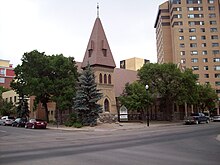St. Paul's Cathedral (Regina, Saskatchewan)
| St Paul's Cathedral | |
|---|---|

St Paul's Cathedral, Regina, 2008
|
|
| Location | Regina, Saskatchewan |
| Country | Canada |
| Denomination | Anglican |
| Website | http://stpaulsregina.com/ |
| History | |
| Founded | 1882 |
| Architecture | |
| Status | Cathedral |
| Administration | |
| Parish | St Paul's |
| Deanery | Wascana |
| Diocese | Qu'Appelle |
| Province | Ruperts Land |
| Clergy | |
| Bishop(s) | The Right Rev. Robert Hardwick |
| Dean | Very Reverend Michael Sinclair |
St Paul's Anglican Cathedral is an historic church building located on the outskirts of Regina's central business district. Built as a parish church in 1894-1895, it became the pro-cathedral of the Anglican Diocese of Qu'Appelle, in southern Saskatchewan, Canada in 1944 when pro-cathedral status was removed from St Peter's, Qu'Appelle, in the eponymous former see city which had become moribund. In 1973, when it had become clear that the once-planned grand cathedral for Regina — at the corner of Broad Street and College Avenue — was no longer a feasible project, its status was raised to that of cathedral.
The church seats approximately 300 people. It is in the approved Cambridge Camden Society configuration with gable roof in keeping with the moderately high church sensibilities of the diocese of Qu'Appelle, albeit of extremely modest appearance both inside and out, reflecting the extreme numerical and financial minority status of Anglicanism in Western Canada and the tendency for moneyed benefactors to be of more mainstream denominational allegiance.
There is a Lady Chapel to the liturgical and geographical south of the chancel and a columbarium in the crypt. The parish dates from the original establishment of the town of Regina in 1882 when the current church site was purchased.
In 1883 a wooden frame building, measuring 50 by 24 feet, was opened and in 1894-1895 the present brick and fieldstone church was built. A chancel and transepts were added in 1905-06. It is the oldest church building in Regina still in use. The organ console until May 1974 was immediately north (both geographically and theologically)of the wall between the chancel and the chapel; the choir west of the altar; the organ pipes to the north of the chancel, behind the pulpit. The new organ pipes were in the north transept, above the choir, with the console at the southwest corner, The console and choir have been variously relocated since then.
It has a curious history as
...
Wikipedia
